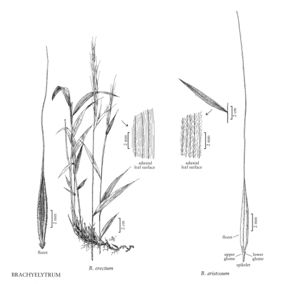Difference between revisions of "Brachyelytrum aristosum"
FNA>Volume Importer |
GeoffLevin (talk | contribs) m (Corrected R Beauv. to P. Beauv. in authority) |
||
| (9 intermediate revisions by 2 users not shown) | |||
| Line 1: | Line 1: | ||
{{Treatment/ID | {{Treatment/ID | ||
|accepted_name=Brachyelytrum aristosum | |accepted_name=Brachyelytrum aristosum | ||
| − | |accepted_authority=(Michx.) | + | |accepted_authority=(Michx.) P. Beauv. ex Branner & Coville |
|publications= | |publications= | ||
|common_names=Northern shorthusk | |common_names=Northern shorthusk | ||
| Line 7: | Line 7: | ||
|synonyms={{Treatment/ID/Synonym | |synonyms={{Treatment/ID/Synonym | ||
|name=Brachyelytrum septentrionale | |name=Brachyelytrum septentrionale | ||
| − | |authority= | + | |authority= |
| − | }}{{Treatment/ID/Synonym | + | |rank=species |
| + | }} {{Treatment/ID/Synonym | ||
|name=Brachyelytrum erectum var. septentrionale | |name=Brachyelytrum erectum var. septentrionale | ||
| − | |authority= | + | |authority= |
| − | }}{{Treatment/ID/Synonym | + | |rank=variety |
| + | }} {{Treatment/ID/Synonym | ||
|name=Brachyelytrum aristatum | |name=Brachyelytrum aristatum | ||
| − | |authority= | + | |authority= |
| + | |rank=species | ||
}} | }} | ||
|hierarchy=Poaceae;Poaceae subfam. Pooideae;Poaceae tribe Brachyelytreae;Brachyelytrum;Brachyelytrum aristosum | |hierarchy=Poaceae;Poaceae subfam. Pooideae;Poaceae tribe Brachyelytreae;Brachyelytrum;Brachyelytrum aristosum | ||
| Line 25: | Line 28: | ||
-->{{Treatment/Body | -->{{Treatment/Body | ||
| − | |distribution=Maine;Va.;Mass.;N.Y.;N.C.;N.J.;Wis.;W.Va.;Mich.;Minn.;N.H.;Vt.;Tenn.;R.I.;Pa.;Ga.;Ind.;Iowa;Conn.;N.B.;Nfld. | + | |distribution=Maine;Va.;Mass.;N.Y.;N.C.;N.J.;Wis.;W.Va.;Mich.;Minn.;N.H.;Vt.;Tenn.;R.I.;Pa.;Ga.;Ind.;Iowa;Conn.;N.B.;Nfld. and Labr. (Labr.);N.S.;Ont.;P.E.I.;Que. |
| − | |discussion=<p>Brachyelytrum aristosum, like B. erectum, grows in moist woods and forests, but its primary distribution is more northern, extending from Ontario to Newfoundland, Minnesota, and Pennsylvania, and south through the Appalachian Mountains to the junction of Tennessee, North Carolina, and Georgia.</p><!-- | + | |discussion=<p><i>Brachyelytrum aristosum</i>, like <i>B. erectum</i>, grows in moist woods and forests, but its primary distribution is more northern, extending from Ontario to Newfoundland, Minnesota, and Pennsylvania, and south through the Appalachian Mountains to the junction of Tennessee, North Carolina, and Georgia.</p><!-- |
| − | --><p>Some authors (e.g., Koyama and Kawano 1964) have called this taxon Brachyelytrum erectum var. glabratum.</p><!-- | + | --><p>Some authors (e.g., Koyama and Kawano 1964) have called this taxon <i>Brachyelytrum erectum</i> <i></i>var.<i> glabratum</i>.</p><!-- |
| − | --><p>As discussed under B. erectum, that name is a nomenclatural synonym of B. erectum sensu stricto. Nevertheless, most plants identified as B. erectum var. glabratum will be found to be B. aristosum.</p> | + | --><p>As discussed under <i>B. erectum</i>, that name is a nomenclatural synonym of <i>B. erectum</i> sensu stricto. Nevertheless, most plants identified as <i>B. erectum</i> <i></i>var.<i> glabratum</i> will be found to be <i>B. aristosum</i>.</p> |
|tables= | |tables= | ||
|references= | |references= | ||
| Line 37: | Line 40: | ||
-->{{#Taxon: | -->{{#Taxon: | ||
name=Brachyelytrum aristosum | name=Brachyelytrum aristosum | ||
| − | + | |authority=(Michx.) P. Beauv. ex Branner & Coville | |
| − | |authority=(Michx.) | ||
|rank=species | |rank=species | ||
|parent rank=genus | |parent rank=genus | ||
| Line 44: | Line 46: | ||
|basionyms= | |basionyms= | ||
|family=Poaceae | |family=Poaceae | ||
| − | |distribution=Maine;Va.;Mass.;N.Y.;N.C.;N.J.;Wis.;W.Va.;Mich.;Minn.;N.H.;Vt.;Tenn.;R.I.;Pa.;Ga.;Ind.;Iowa;Conn.;N.B.;Nfld. | + | |illustrator=Linda Ann Vorobik |
| + | |illustration copyright=Utah State University | ||
| + | |distribution=Maine;Va.;Mass.;N.Y.;N.C.;N.J.;Wis.;W.Va.;Mich.;Minn.;N.H.;Vt.;Tenn.;R.I.;Pa.;Ga.;Ind.;Iowa;Conn.;N.B.;Nfld. and Labr. (Labr.);N.S.;Ont.;P.E.I.;Que. | ||
|reference=None | |reference=None | ||
|publication title= | |publication title= | ||
|publication year= | |publication year= | ||
|special status= | |special status= | ||
| − | |source xml=https:// | + | |source xml=https://bitbucket.org/aafc-mbb/fna-data-curation/src/200273ad09963decb8fc72550212de541d86569d/coarse_grained_fna_xml/V24/V24_67.xml |
|subfamily=Poaceae subfam. Pooideae | |subfamily=Poaceae subfam. Pooideae | ||
|tribe=Poaceae tribe Brachyelytreae | |tribe=Poaceae tribe Brachyelytreae | ||
Latest revision as of 19:35, 1 December 2021
Culms (28)41-78(96) cm long, 0.6-1 mm thick; nodes densely pilose; internodes glabrous or hispid, occasionally retrorsely pubescent near the nodes. Sheaths pubescent; ligules of middle and upper cauline blades 1.8-2.5 mm, acute, erose; blades (6.9)8.6-13 (16.1) cm long, 8-16 mm wide, abaxial surfaces sparsely pilose, adaxial surfaces with some hairs usually restricted to the veins, margins scabrous, with (1)4-10(12) prickles and (1)1-9 macrohairs per mm. Panicles (6.6)9.5-17.5 cm. Spikelets, including the awns, 23-36 mm. Lower glumes 0.1-0.4(0.9) mm, sometimes absent; upper glumes 0.6-1.7(3) mm; calluses hairy, hairs 0.2-0.5 mm; lemmas 8-10(11) mm long, 0.7-1.4 mm wide, veins scabridulous, scabrules 0.08-0.14(0.2) mm, all veins equally prominent; awns (14)17-24(26) mm; paleas 7.7-11.5 mm; anthers 2-3.5 mm. Caryopses 5.5-7.5 mm. 2n = 22.
Distribution
Maine, Va., Mass., N.Y., N.C., N.J., Wis., W.Va., Mich., Minn., N.H., Vt., Tenn., R.I., Pa., Ga., Ind., Iowa, Conn., N.B., Nfld. and Labr. (Labr.), N.S., Ont., P.E.I., Que.
Discussion
Brachyelytrum aristosum, like B. erectum, grows in moist woods and forests, but its primary distribution is more northern, extending from Ontario to Newfoundland, Minnesota, and Pennsylvania, and south through the Appalachian Mountains to the junction of Tennessee, North Carolina, and Georgia.
Some authors (e.g., Koyama and Kawano 1964) have called this taxon Brachyelytrum erectum var. glabratum.
As discussed under B. erectum, that name is a nomenclatural synonym of B. erectum sensu stricto. Nevertheless, most plants identified as B. erectum var. glabratum will be found to be B. aristosum.
Selected References
None.
